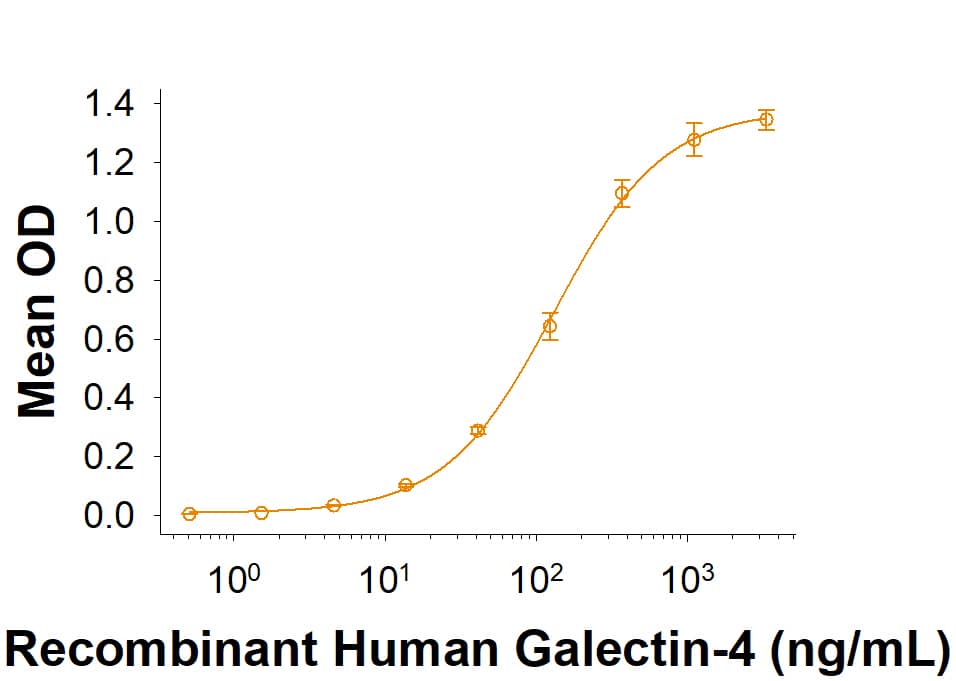Recombinant Human CEACAM-5/CD66e Fc Avi-tag Protein, CF
R&D Systems, part of Bio-Techne | Catalog # AVI10449
Biotinylated

Key Product Details
Learn more about Avi-tag Biotinylated Proteins
Source
CHO
Accession #
Structure / Form
Disulfide-linked homodimer, biotinylated via Avi-tag
Conjugate
Biotin
Applications
Bioactivity
Product Specifications
Source
Chinese Hamster Ovary cell line, CHO-derived human CEACAM-5/CD66e protein
| Human CEACAM-5/CD66e (Lys35-Ala685) Accession # NP_004354.3 |
IEGRMD | Human IgG1 (Pro100-Lys330) |
Avi-tag |
| N-terminus | C-terminus | ||
Purity
>95%, by SDS-PAGE visualized with Silver Staining and quantitative densitometry by Coomassie® Blue Staining.
Endotoxin Level
<0.10 EU per 1 μg of the protein by the LAL method.
N-terminal Sequence Analysis
Lys35
Predicted Molecular Mass
100 kDa
SDS-PAGE
145-165 kDa, under reducing conditions
Activity
The biotin to protein ratio is greater than 0.7 as determined by the HABA assay.
Measured by its binding ability in a functional ELISA.
When Biotinylated Recombinant Human CEACAM-5/CD66e Fc Chimera Avi-tag (Catalog # AVI10449) is immobilized at 1 µg/mL (100 µL/well), Recombinant Human Galectin-4 (Catalog # 1227-GA) binds with an ED50 of 35-280 ng/mL.
Measured by its binding ability in a functional ELISA.
When Biotinylated Recombinant Human CEACAM-5/CD66e Fc Chimera Avi-tag (Catalog # AVI10449) is immobilized at 1 µg/mL (100 µL/well), Recombinant Human Galectin-4 (Catalog # 1227-GA) binds with an ED50 of 35-280 ng/mL.
Scientific Data Images for Recombinant Human CEACAM-5/CD66e Fc Avi-tag Protein, CF
Biotinylated Recombinant Human CEACAM-5/CD66e Fc Chimera Avi-tag Protein Binding Activity.
When Biotinylated Recombinant Human CEACAM-5/CD66e Fc Chimera Avi-tag (Catalog # AVI10449) is immobilized at 1 µg/mL (100 µL/well), Recombinant Human Galectin-4 (1227-GA) binds with an ED50 of 35-280 ng/mL.Biotinylated Recombinant Human CEACAM-5/CD66e Fc Chimera Avi-tag Protein SDS-PAGE.
2 μg/lane of Biotinylated Recombinant Human CEACAM-5/CD66e Fc Chimera Avi-tag Protein (Catalog # AVI10449) was resolved with SDS-PAGE under reducing (R) and non-reducing (NR) conditions and visualized by Coomassie® Blue staining, showing bands at 145-165 kDa and 290-330 kDa, respectively.Formulation, Preparation and Storage
AVI10449
| Formulation | Lyophilized from a 0.2 μm filtered solution in PBS with Trehalose. |
| Reconstitution | Reconstitute at 500 μg/mL in PBS. |
| Shipping | The product is shipped at ambient temperature. Upon receipt, store it immediately at the temperature recommended below. |
| Stability & Storage | Use a manual defrost freezer and avoid repeated freeze-thaw cycles.
|
Background: CEACAM-5/CD66e
References
- Zebhauser, R. et al. (2005) Genomics 86:566.
- Hammarstrom, S. (1999) Semin. Cancer Biol. 9:67.
- Chan, et al. (2007) Curr Oncol. 14:70.
- Schrewe H. et al. (1990) Mol. Cell. Biol. 10:2738.
- Hefta, S.A. et al. (1988) Proc. Natl. Acad. Sci. 85:4648.
- Hance KW et al. Mutat Res. (2005) 576:132.
- Stern, N. et al. (2005) J. Immunol. 174:6692.
- Beauchemin N. et al. (2013) Cancer Metastasis Rev. 32:3.
- Blumenthal, R.D. et al. (2005) Cancer Res. 65:8809.
- Screaton, R.A. et al. (1997) J. Cell Biol. 137:939.
- Ordonez, C. et al. (2000) Cancer Res. 60:3419.
- Yamamoto, Y. et al. (2005) Biochem. Biophys. Res. Commun. 333:223.
- Martin, J.N. et al. (2016) Biochemistry. 55:4286
- Berger, C.N. et al. (2004) Mol. Microbiol. 52:963.
- Tchoupa, A.K. et al. (2014) Cell Commun Signal. 12:27.
Long Name
Carcinoembryonic Antigen-related Cell Adhesion Molecule 5
Alternate Names
CD66e, CEA, CEACAM5
Gene Symbol
CEACAM5
UniProt
Additional CEACAM-5/CD66e Products
Product Documents for Recombinant Human CEACAM-5/CD66e Fc Avi-tag Protein, CF
Product Specific Notices for Recombinant Human CEACAM-5/CD66e Fc Avi-tag Protein, CF
For research use only
